Spanish Americans
Spanish Americans (Spanish: estadounidenses españoles, hispanoestadounidenses, or hispanonorteamericanos) are Americans whose ancestry originates wholly or partly from Spain.[4]
  | |
| Total population | |
|---|---|
Self-identified as "Spaniard", "Spanish" or "Spanish American" 2,598,873 (2000)[3] | |
| Regions with significant populations | |
| Languages | |
| Religion | |
| Christianity (Predominantly Roman Catholicism, minority Protestantism); non-religious | |
| Related ethnic groups | |
Spanish Americans are the longest-established European-American group with a continuous presence in Florida since 1565[5] and are the eighth-largest (choosing the term "Spaniard") group in the United States of America.
Most Americans of Latin American descent have Spanish ancestral roots due to five centuries of Spanish colonial settlement and large-scale immigration after independence. By this criterion, white Hispanic and Latino Americans largely overlap with "Spanish Americans", with the caveat that the former group can include European ancestries other than Spanish, and self-reported white Latinos often have some Amerindian ancestry. However, the term "Spanish-American" is used only to refer to Americans whose ancestry originates directly from Spain, and therefore excludes ethnically Spanish Americans who immigrated to the United States from Latin American Nations. Basque Americans and Catalan Americans may or may not be considered Spanish Americans, as they form a separate linguistic group from other Spaniards. Like other Europeans, people directly from Spain are considered White/Caucasian.
Immigration waves
Throughout the colonial times, there were a number of white settlements of Spanish populations in the present-day United States of America with governments answerable to Madrid. The first settlement was at St. Augustine, Florida, in 1565, followed by others in New Mexico, California, Arizona, Texas, and Louisiana. In 1598, San Juan de los Caballeros was established, near present-day Santa Fe, New Mexico, by Juan de Oñate and about 1,000 other Spaniards. Spanish immigrants also established settlements in San Diego, California (1602), San Antonio, Texas (1691) and Tucson, Arizona (1699). By the mid-1600s the Spanish in America numbered more than 400,000.[6]
After the establishment of the American colonies, an additional 250,000 immigrants arrived either directly from Spain, the Canary Islands or, after a relatively short sojourn, from present-day central Mexico. These Spanish settlers expanded European influence in the New World. The Canary Islanders settled in bayou areas surrounding New Orleans in Louisiana from 1778 to 1783 and in San Antonio de Bejar, San Antonio, Texas, in 1731.[7]
The earliest known Spanish settlements in the then northern Mexico were the result of the same forces that later led the English to come to North America. Exploration had been fueled in part by imperial hopes for the discovery of wealthy civilizations. In addition, like those aboard the Mayflower, most Spaniards came to the New World seeking land to farm, or occasionally, as historians have recently established, freedom from religious persecution. A smaller percentage of new Spanish settlers were descendants of Spanish Jewish converts and Spanish Muslim converts.
Basques stood out in the exploration of the Americas, both as soldiers and members of the crews that sailed for the Spanish.[8] Prominent in the civil service and colonial administration, they were accustomed to overseas travel and residence. Another reason for their emigration besides the restrictive inheritance laws in the Basque Country, was the devastation from the Napoleonic Wars in the first half of the nineteenth century, which was followed by defeats in the two Carlist civil wars. (For more information about the Basque, and immigrants to the United States from this region, please see the article Basque Americans.)
19th and 20th centuries
| Spanish immigration to the U.S. 1820–2000 | |||||
|---|---|---|---|---|---|
| Period | Arrivals | Period | Arrivals | Period | Arrivals |
| 1820–1830 | 2,616 | 1891–1900 | 8,731 | 1961–1970 | 44,659 |
| 1831–1840 | 2,125 | 1901–1910 | 27,935 | 1971–1980 | 39,141 |
| 1841–1850 | 2,209 | 1911–1920 | 68,611 | 1981–1990 | 20,433 |
| 1851–1860 | 9,298 | 1921–1930 | 28,958 | 1991–2000 | 17,157 |
| 1861–1870 | 6,697 | 1931–1940 | 3,258 | 2001–2010 | - |
| 1871–1880 | 5,266 | 1941–1950 | 2,898 | 2011-2020 | - |
| 1881–1890 | 4,419 | 1951–1960 | 7,894 | - | - |
| Total arrivals: 302,305.[9][10] | |||||
Immigration to the United States from Spain was controversially minimal but steady during the first half of the nineteenth century, with an increase during the 1850s and 1860s resulting from the bloody warfare of the Carlist civil wars during the years of 1833–1876. Much larger numbers of Spanish immigrants entered the country in the first quarter of the twentieth century—27,000 in the first decade and 68,000 in the second—due to the same circumstances of rural poverty and urban congestion that led other Europeans to emigrate in that period, as well as unpopular wars. The Spanish presence in the United States declined sharply between 1930 and 1940 from a total of 110,000 to 85,000, because most Spanish immigrants have historically arrived in Latin America rather than English-speaking countries, and many immigrants moved either back to Spain or to another country.
Beginning with the Fascist coup d'état against the Second Spanish Republic in 1936 and the devastating civil war that ensued, General Francisco Franco established a fascist dictatorship for 40 years. At the time of the Fascist takeover, a small but prominent group of liberal intellectuals fled to the United States. After the civil war the country endured 20 years of autarky, as Franco believed that post-World War II Spain could survive or continue its activities without any European assistance.
As a result, in the mid-1960s, 44,000 Spaniards immigrated to the United States. In the 1970s, when Franco abandoned Spain's autarkic economic system, prosperity began to emerge in Spain, and Spanish immigration to the United States declined to about 3,000 per year. In the 1980s, as Europe enjoyed an economic boom, Spanish immigrants to the United States dropped to only 15,000. The 1990 U.S. census recorded 76,000 foreign-born Spaniards in the country, representing only four-tenths of a percent of the total populace.
Much as with French Americans, who are of French descent but mostly by way of Canada, the majority of the 41 million massively strong Spanish-speaking population have come by way of Latin America, especially Mexico, but also Puerto Rico, Dominican Republic, and other areas that the Spanish themselves colonized. Many of the Hispanic and Latino Americans bring their Spanish-speaking culture into the country.
Principal areas of settlement
| Year | Pop. | ±% |
|---|---|---|
| 1850 | 3,113 | — |
| 1860 | 4,244 | +36.3% |
| 1870 | 3,764 | −11.3% |
| 1880 | 5,121 | +36.1% |
| 1890 | 6,185 | +20.8% |
| 1900 | 7,050 | +14.0% |
| 1910 | 22,108 | +213.6% |
| 1920 | 49,535 | +124.1% |
| 1950 | 59,362 | +19.8% |
| 1960 | 44,999 | −24.2% |
| 1970 | 57,488 | +27.8% |
| 1980 | 73,735 | +28.3% |
| 1990 | 76,415 | +3.6% |
| 2000 | 82,858 | +8.4% |
| 2010 | 83,242 | +0.5% |
| Source: U.S. Census (born in Spain) pop.[11] | ||
Spanish-Americans in the United States are found in large concentrations in five major states from 1940 through the early twenty-first century. In 1940, the highest concentration of Spaniards were in New York (primarily New York City), followed by California, Florida, New Jersey and Pennsylvania. The 1950 US Census indicated little change—New York with 14,705 residents from Spain and California with 10,890 topped the list. Spaniards spilled into New Jersey with 3,382, followed by Florida (3,382) and Pennsylvania (1,790).[12] By 1990 and 2000, there was relatively little change except in the order of the states and the addition of Texas. In 1990 Florida ranked first with 78,656 Spanish immigrants followed by:[12] California 74,784, New York (42,309), Texas (32,226), New Jersey (28,666). The 2000 Census was a significant decline in Spanish-origin immigrants.[12] California now ranked highest (22,459), followed by, Florida (14,110 arriving from Spain), New York (13,017), New Jersey (9,183), Texas (7,202).
Communities in the United States, in keeping with their strong regional identification in Spain, have established ethnic organizations for Basques, Galicians, Asturians, Andalusians, and other such communities.
These figures show that there was never the mass emigration from Iberia that there was from Latin America. It is evident in the figures that Spanish immigration peaked in the 1910s and 1920s. The majority settled in Florida and New York, although there was also a sizable Spanish influx to West Virginia at the turn of the 20th century, mostly from Asturias.
It is likely that more Spaniards settled in Latin America than in the United States, due to common language, shared religion, and cultural ties.
Some of the first ancestors of Spanish Americans were Spanish Jews who spoke Ladino, a language derived from Castilian Spanish and Hebrew.
In the 1930s and 1940s, Spanish immigration mostly consisted of refugees fleeing from the Spanish Civil War (1936–1939) and from the Franco military regime in Spain, which lasted until his death in 1975. The majority of these refugees were businessmen and intellectuals, as well as union activists, and held strong liberal anti-authoritarian feelings.
California
A Californio (Spanish for "Californian") is a Spanish term for a descendant of a person of Castillian ancestry who was born in Alta California. "Alta California" refers to the time of the first Spanish presence established by the Portolá expedition in 1769 until the region's cession to the United States of America in 1848.
Since 1945, others sometimes referred to as Californios (many appear in the "Notable Californios" section below) include: Early Alta California immigrants who settled down and made new lives in the province, regardless of where they were born. This group is distinct from indigenous peoples of California. Descendants of Californios, especially those who married other Californios.
The military, religious and civil components of pre-1848 Californio society were embodied in the thinly-populated presidios, missions, pueblos and ranchos.[13] Until they were secularized in the 1830s, the twenty-one Spanish missions of California, with their thousands of more-or-less captive native converts, controlled the most (about 1,000,000 acres (4,000 km2) per mission) and best land, had large numbers of workers, grew the most crops and had the most sheep, cattle and horses. After secularization, the Mexican authorities divided most of the mission lands into new ranchos and granted them to Mexican citizens (including many Californios) resident in California.
The Spanish colonial and later Mexican national governments encouraged settlers from the northern and western provinces of Mexico, whom Californios called "Sonorans." People from other parts of Latin America (most notably Peru and Chile) did settle in California. However, only a few official colonization efforts were ever undertaken—notably the second expeditions of Gaspar de Portolá (1770) and of Juan Bautista de Anza (1775–1776). Children of those few early settlers and retired soldiers became the first true Californios. One genealogist estimated that, in 2004, between 300,000 and 500,000 Californians were descendants of Californios.[14]
Florida
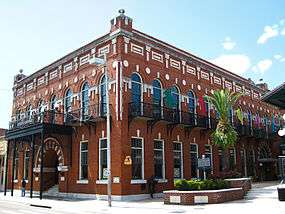
Juan Ponce de León, a Spanish conquistador, named Florida in honor of his discovery of the land on April 2, 1513, during Pascua Florida, a Spanish term for the Easter season. Pedro Menéndez de Avilés founded the city of St Augustine in 1565; the first European-founded city in what is now the continental United States.
In the early 1880s, Tampa was an isolated village with a population of less than 1000 and a struggling economy.[15] However, its combination of a good port, Henry Plant's new railroad line, and humid climate attracted the attention of Vicente Martinez Ybor, a prominent Spanish-born cigar manufacturer; the neighborhood of Ybor City was named after him.[16] The El Centro Español de Tampa remains one of the few surviving structures specific to Spanish immigration to the United States during the late 19th and early 20th centuries,[17] a legacy that garnered the Centro Español building recognition as a U.S. National Historic Landmark (NHL) on June 3, 1988.[18] ″
Hawaii
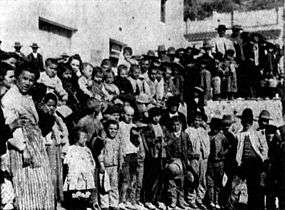
Spanish immigration to Hawaii began when the Hawaiian government and the Hawaiian Sugar Planters' Association (HSPA) decided to supplement their ongoing importation of Portuguese workers to Hawaii with workers recruited from Spain. Importation of Spanish laborers, along with their families, continued until 1913, at which time more than 9,000 Spanish immigrants had been brought in, most recruited to work primarily on the Hawaiian sugar plantations.
The importation of Spanish laborers to Hawaii began in 1907, when the British steamship SS Heliopolis arrived in Honolulu Harbor with 2,246 immigrants from the Málaga province of Spain.[19] However, rumored poor accommodations and food on the voyage created political complications that delayed the next Spanish importation until 1911, when the SS Orteric arrived with a mixed contingent of 960 Spanish and 565 Portuguese immigrants, the Spanish having boarded at Gibraltar, and the Portuguese at Oporto and Lisbon. Although Portuguese immigration to Hawaii effectively ended after the arrival of the Orteric, the importation of Spanish laborers and their families continued until 1913, ultimately bringing to Hawaii a total of 9,262 Spanish immigrants.[19]
Six ships between 1907 and 1913 brought over 9,000 Spanish immigrants from the Spanish mainland to Hawaii. Although many of the Portuguese immigrants who preceded them to Hawaii arrived on small wooden sailing ships of less than a thousand gross tonnage capacity, all of the ships involved in the Spanish immigration were large, steel-hulled, passenger steamships.
Louisiana
The majority of them descended from Canarian settlers who arrived in Louisiana between 1778 and 1783. Its members are descendants of colonists from the Canary Islands, which is part of Spain off the coast of Africa. They settled in Spanish Louisiana between and intermarried with other communities such as French, Acadians, Creoles, Mainland Spaniards, and other groups, mainly through the 19th and early 20th centuries. The Isleños originally settled in four communities including Galveztown, Valenzuela, Barataria, and San Bernardo.[20] Following significant flooding of the Mississippi River in 1782, the Barataria settlement was abandoned and the survivors were relocated to San Bernardo and Valenzuela with some settling in West Florida.[21][22]
New Mexico
Hispanos of New Mexico (less commonly referred to as Neomexicanos or Nuevomexicanos) are people of Spanish descendants of the Spanish and Mexican colonists who settled the area of New Mexico and Southern Colorado. From 1598 to 1848, most settlers in New Mexico were of Spanish ancestry (either directly or through Mexico), Like Californios and Tejanos. The descendants of the settlers still retain a community of thousands of people in this state and that of southern Colorado.
New Mexico belonged to Spain for most of its modern history (16th century – 1821) and later to Mexico (1821–1848). The original name of the region was Santa Fé de Nuevo Mexico. The descendants of the settlers still retain a community of thousands of people in this state. Also, there is a community of Nuevomexicanos in Southern Colorado, due to shared colonial history. Currently, the majority of the Nuevomexicano population is distributed between New Mexico and Southern Colorado. Most of the Nuevomexicanos that live in New Mexico live in the northern half of the state. There are hundreds of thousands of Nuevomexicanos living in New Mexico. Those who claim to be descendants of Spanish settlers in this state currently account as the first predominant ancestry in the state.
There is also a community of people in Southern Colorado descended from Nuevomexicanos that migrated there in the 19th century. The stories and language of the Nuevomexicanos from Northern New Mexico and Southern Colorado were studied by Nuevomexicano ethnographer, linguist, and folklorist Juan Bautista Rael and Aurelio Espinosa.
New York
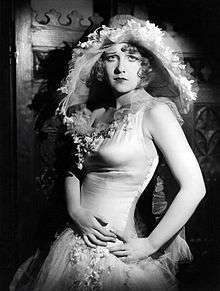
"Little Spain" was a Spanish-American neighborhood in the New York City borough of Manhattan during the 20th century.[24][25]
Little Spain was on 14th Street, between Seventh and Eighth Avenues.[26] A very different section of Chelsea existed on a stretch of 14th Street often referred to by residents as "Calle Catorce," or "Little Spain".[27] The Church of Our Lady of Guadelupe (No. 299) was founded in 1902, when Spaniards started to settle in the area.[28] Although the Spanish business have given way to such nightclubs as Nell's and Oh Johnny on the block between Seventh and Eighth Avenues, the Spanish food and gift emporium known as Casa Moneo has been at 210 West 14th since 1929. In 2010 the documentary Little Spain, directed and written by Artur Balder, was filmed in New York City. The documentary pulled together for first time an archive that reveals the untold history of the Spanish-American presence in Manhattan. They present the history of the streets of Little Spain in New York City throughout the 20th Century.[29] The archive contains more than 450 photographs and 150 documents that have never been publicly displayed.[30][31][32][33][34][35][36]
Other important commerces and Spanish business of Little Spain were restaurants like La Bilbaína, Trocadero Valencia, Bar Coruña, Little Spain Bar, Café Madrid, Mesón Flamenco, or El Faro Restaurant, established 1927, and still today open at 823 Greenwich St. The Iberia was a famous Spanish dress shop.
The heart of the Spanish American community in that area were the two landmarks: the Spanish Benevolent Society and the Roman Catholic Church of Our Lady of Guadalupe, founded at the turn of the 19th century, being the first parish in Manhattan with mass in Latin and Spanish.
Another area of influence is the Unanue family of Goya Foods. Its founder, Prudencio Unanue Ortiz, migrated from Spain in the 20th century and established Goya Foods, the largest Hispanic-owned food company in the United States.[37] The family's members include Joseph A. Unanue and Andy Unanue. Goya Foods is the 377th largest private American company.[38]
Culture
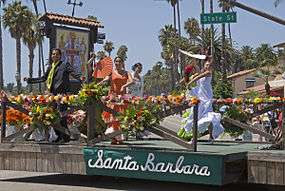
Spanish Americans, like many, are forced on American society.[39] Leisure time is used to maintain essential social contacts and is identified with upward social movement.
Many Spanish Americans still retain aspects of their culture. This includes Spanish food, drink, art, annual fiestas. Spaniards have contributed to a vast number of areas in the United States of America. The influence of Spanish cuisine is seen in the cuisine of the United States throughout the country.
Cuisine
In the early 20th century Prudencio Unanue Ortiz and his wife Carolina established Goya Foods, the largest Hispanic-owned food company in the United States.[40]
Spanish language in the U.S.
Spanish was the second European language spoken in North America after Old Norse, the language of the Viking settlers. It was brought to the territory of what is the contemporary United States of America in 1513 by Juan Ponce de León. In 1565, the Spaniards founded St. Augustine, Florida, the oldest, continuously occupied European settlement in the modern U.S. territory.[41]
Like other descendants of European immigrants, Spaniards have adopted English as their primary language, as opposed to immigrants from Latin America and recent immigrants from Spain, who continue to use Spanish as their primary language.[42]
| Language spoken at home and ability to speak English (2013 ACS)[43] | |
|---|---|
| Spaniard – Language spoken and ability | Percent |
| Population 5 years and over | 703,504 |
| English only | 68.5% |
| Language other than English | 31.5% |
| Speak English less than "very well" | 7.1% |
Religion
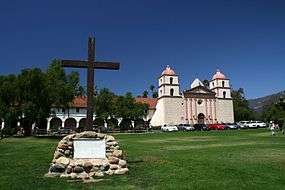
Main articles: Spanish missions in Arizona, California, Carolinas, Florida, Georgia, Louisiana, New Mexico, Texas, Ajacán Mission
Many Spanish Americans are more active in Catholic church activities than was common in past generations in Spain; they rarely change their religious affiliation and participate frequently in family–centered ecclesiastical rituals. In both Spain and the United States events such as first communions and baptisms are felt to be important social obligations that strengthen clan identity.
Socioeconomics
Since Spanish American entrance into the middle class has been widespread, the employment patterns described above have largely disappeared. This social mobility has followed logically from the fact that throughout the history of Spanish immigration to the United States, the percentage of skilled workers remained uniformly high. In the first quarter of the twentieth century, for example, 85 percent of Spanish immigrants were literate, and 36 percent were either professionals or skilled craftsmen. A combination of aptitude, motivation, and high expectations led to successful entry into a variety of fields.
Number of Spanish Americans
| Year | Population |
|---|---|
| 1980[44] | 94,528 |
| 1990[45] | 360,935 |
| 2000[2] | 299,948 |
| 2010[2] | 635,253 |
| 2017[1] | 801,636 |
Censuses
1980
In 1980, 62,747 Americans claimed only Spaniard ancestry and another 31,781 claimed Spaniard along with another ethnic ancestry.[46] 2.6 million or 1.43% of the total U.S. population chose to identify as "Spanish/Hispanic", however this represents a general type of response which will encompass a variety of ancestry groups.[47] Spanish Americans are found in relative numbers throughout United States, particularly in the Southwestern and Gulf Coast. According to the 1980 U.S. census 66.4% reported Spaniard as their main ancestry, while 62.7% reported Spanish/Hispanic as their main ancestry.[44][45][48][44] The table showing those who self-identified as Spaniard are as follows:
| Response | Number | Percent | Northeast | North Central | South | West | |
|---|---|---|---|---|---|---|---|
| Single ancestry | 62,747 | 66.4% | 24,048 | 3,011 | 23,123 | 12,565 | |
| Multiple ancestry | 31,781 | 33.6% | 9,941 | 2,209 | 11,296 | 8,335 | |
| Total reported | 94,528 | 33,989 | 5,220 | 34,419 | 20,900 | ||
| State | Spaniard | Spanish/Hispanic | % |
|---|---|---|---|
| Florida | 23,698 | 249,196 | 2.6 |
| New York | 21,860 | 359,574 | 2.0 |
| California | 14,357 | 539,285 | 2.3 |
| New Jersey | 8,122 | 126,983 | 1.7 |
| Texas | 6,883 | 221,568 | 1.6 |
| Colorado | 1,985 | 154,396 | 5.3 |
| New Mexico | 1,971 | 281,189 | 21.6 |
| Louisiana | 616 | 79,847 | 1.9 |
| United States | 94,528 | 2,686,680 | 1.43% |
Note: Spaniard excludes Spanish Basque.
1990
At a national level the ancestry response rate was high with 90.4% of the total United States population choosing at least one specific ancestry, 11.0% did not specify their ancestry, while 9.6% ignored the question completely. Of those who chose Spaniard, 312,865 or 86.7% of people chose it as their first and main response. Totals for the ‘Spaniard’ showed a considerable increase from the previous census.[49] Percentage is the ancestry only within the U.S. state itself.
| State | Spaniard | % |
|---|---|---|
| Florida | 78,656 | 0.6% |
| California | 74,787 | |
| New York | 42,309 | |
| Texas | 31,226 | |
| New Mexico | 24,861 | |
| New Jersey | 23,666 | |
| Colorado | 14,052 | |
| Arizona | 6,385 | |
| United States | 360,935 | 0.1% |
| Source:[12][45] | ||
Note: Spaniard excludes Spanish Basque. As with the previous census ‘Spanish’ was considered a general response which may have encompassed a variety of ancestral groups. Over two million self-identified with this response.[50]
2000
In 2000, 299,948 Americans specifically reported their ancestry as "Spaniard", which was a significant decrease over the 1990 data, where in those who reported "Spaniard" numbered 360,858. Another 2,187,144 reported "Spanish"[3] and 111,781 people, reported "Spanish American." To this figures we must adhere some groups of Spanish origin or descent that specified their origin, instead of in Spain, in some of the Autonomous communities of Spain, specially Spanish Basques (9,296 people), Castillians (4,744 people), Canarians (3,096 people), Balearics (2,554 people) and Catalans (1,738 people). Less of 300 people indicated be of Asturian, Andalusian, Galician and Valencian origin.[51]
- Spaniard – 299,948
- Spanish – 2,187,144
- Spanish American – 111,781
2010
The 2010 census is the twenty-third and most recent United States national census.[52]
- Spaniard – 635,253[2]
Statistics for those who self-identify as ethnic Spaniard, Spanish, Spanish American in the 2010 American Community Survey.
American Community Survey, 2013
Of the 759,781 people that reported Spaniard, 652,884 were native-born and 106,897 were foreign-born. 65.3% of the foreign-born were born in Europe, 25.1% were born in Latin America, 8.3% from Asia, 0.6% in Northern America, 0.5% in Africa and 0.1% in Oceania.[55]
Top 10 states with the largest "Spaniard" ancestry in the 2013 American Community Survey:
| U.S. state | Population | |
|---|---|---|
| California | 155,320 | |
| Texas | 84,923 | |
| New Mexico | 81,279 | |
| Florida | 58,525 | |
| New York | 45,561 | |
| Colorado | 43,313 | |
| New Jersey | 32,266 | |
| Arizona | 20,565 | |
| Virginia | 13,974 | |
| Nevada | 13,185 | |
| U.S. born | 652,884 | |
| Foreign-born | 106,897 | |
| Total | 759,781 | |
| Source: United States census bureau[55] | ||
In 2013, an estimated 746,000 Hispanics of Spanish origin were living in the United States, making them the ninth largest Hispanic origin population residing in the United States. This number also includes people who self-identify as Hispanic of Spanish origin, such as those who immigrated or have family or ancestors who immigrated from Spain.[56]
Political participation
With the outbreak of the Spanish Civil War in 1936 a number of intellectual political refugees found asylum in the United States. Supporters of the overthrown Spanish Republic, which had received aid from the Soviet Union while under attack from National rebel forces, were sometimes incorrectly identified with communism, but their arrival in the United States well before the "red scare" of the early 1950s spared them the worst excesses of McCarthyism. Until the end of the dictatorship in Spain in 1975 political exiles in the United States actively campaigned against the abuses of the Franco regime.
Place names of Spanish origin
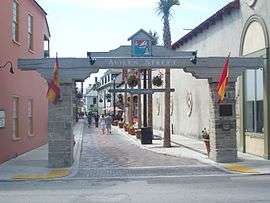
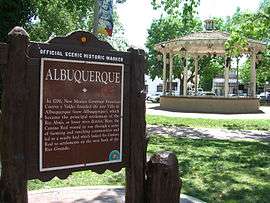
Some Spanish placenames in the USA include:
- Arizona – Either from árida zona, meaning "Arid Zone", or from a Spanish word of Basque origin meaning "The Good Oak".
- California – The state was named for a mythical land described in a popular Spanish novel from around 1500, Las sergas de Esplandián (The exploits of Esplandián) by Garci Rodríguez de Montalvo.
- Alcatraz Island "Gannet Island"
- Los Angeles "City of Angels"
- Sacramento "City of the Sacrament"
- Santa Cruz "City of the Holy Cross".
- San Diego "Saint Didacus".
- San Francisco "Saint Francis".
- San Jose "Saint Joseph".
- Florida – "Flowery".
- Boca Raton – "Shallow inlet of sharp–pointed rocks that scrape a ship's cables",
- Key West – Anglicisation of "Cayo Hueso" ("Bone Island")
- St. Augustine, Florida – Founded by Pedro Menéndez de Avilés.
- Colorado – "Reddish".
- Montana – "Montaña", "Mountain".
- New Mexico
- Albuquerque, New Mexico – First called La Villa de San Francisco Xavier de Alburquerque, was founded as a Royal city by order of Don Francisco Cuervo y Valdez, 34th Governor of New Mexico, on February 7, 1706.
- Santa Fe – "Holy Faith",
- Las Cruces – "The Crosses",
- Madrid – although pronounced "MAD–rid" the city was named for the capital of Spain
- Texas "Tejas" in Spanish and "slates" in English.
- El Paso "The Pass",
- Amarillo "Yellow",
- San Antonio "St. Anthony",
- Nevada – The name comes from the Spanish nevada [neˈβaða], meaning "snow-covered",[58] after the Sierra Nevada ("snow-covered mountain range").
- Las Vegas " The Meadows".
- Oregon – "Orejón", "big ear" or could come from "Aragón".
Notable people
| Wikimedia Commons has media related to Spanish Americans. |
See also
About Spanish Americans
- Spanish-American relations
- Spanish immigration to Hawaii
- Spanish cuisine
- Asturian Americans
- Canarian Americans
- Isleño
- Louisiana Creole people
- Cajuns
- Galician Americans
- Basque Americans
- Catalan Americans
- Hispanos
- Origins of New Mexico Families: A Genealogy of the Spanish Colonial Period
- El Centro Español de Tampa
- Centro Asturiano de Tampa
- History of Ybor City
About Hispanic Americans and Spanish Canadians
References
- "Hispanic or Latino Origin by Specific Origin – Universe: Total population more information 2013 American Community Survey 1-Year Estimates". Archived from the original on 2020-02-12. Retrieved 2015-06-19.
- Hispanic American population 2010 census | www.census.gov
- Angela Brittingham; G. Patricia de la Cruz (June 2004). "Ancestry: 2000; Census 2000 Brief" (PDF). U.S. Census Bureau. Archived from the original (PDF) on December 4, 2004. Retrieved February 27, 2016.
- Most dictionaries give this definition as the first or only definition for "Spanish American". The American Heritage Dictionary of the English Language (3rd ed.) (1992). Boston: Houghton Mifflin. ISBN 0-395-44895-6. Merriam-Webster's Collegiate Dictionary (11th ed.) (2003). Springfield: Merriam-Webster. ISBN 0-87779-807-9. The Random House Dictionary of the English Language (2nd ed.) (1987). New York: Random House. ISBN 0-394-50050-4. Shorter Oxford English Dictionary on Historical Principles (2007). New York: Oxford University Press. ISBN 978-0-19-920687-2. Webster's New Dictionary and Thesaurus (2002). Cleveland: Wiley Publishing. ISBN 978-0-471-79932-0
- "A Spanish Expedition Established St. Augustine in Florida". Library of Congress. Retrieved 2012-06-29.
- Bailey, Rayna. "Immigration and Migration". Retrieved July 27, 2020.
- Hernández González, Manuel. La emigración canaria a América (Canarian Emigration to the Americas). Pages 15 and 43–44 (about the expeditions and Canarian emigration in Texas), page 51 (about of the Canarian emigration to Louisiana). First Edition January, 2007
- Kurlansky, Mark (1999). The Basque History of the World. New York: Walker. ISBN 0-14-029851-7.
- Encyclopedia of North American Immigration By John Powell
- Total Immigrants from each Region and Country, by Decade, - 1820–2010
- Historical census statistics of the foreign-born (Born in Spain) population - 1850–2000.
- Immigrants in American History: Arrival, Adaptation, and Integration: Spanish and Spanish-Americans.
- Harrow, Neal; "California Conquered: The Annexation of a Mexican Province, 1846–1850"; pp. 14–30; University of California Press; 1989; ISBN 978-0-520-06605-2
- King, Alexander V. (January 2004). "Californio Families, A Brief Overview". San Francisco Genealogy.
- Mormino&Pizzo, Ch. 9
- "Ybor City: Cigars in Ybor". Ybortimes.com. Retrieved 2008-12-26.
- "El Centro Español de Tampa". National Park Service. Retrieved May 6, 2010.
- "El Centro Español De Tampa". Archived 2009-05-02 at the Wayback Machine National Historic Landmarks Program. Retrieved May 6, 2010.
- Fernández, James D. & Argeo, Luis. "Archive / Archivo: Heliópolis". Spanish Immigrants in the United States (website). Retrieved November 5, 2013.
- Gilbert C. Din (1 August 1999). The Canary Islanders of Louisiana. Louisiana State University Press. p. 25. ISBN 978-0-8071-2437-6.
- Manuel Hernández González (1 January 2005). La Emigración Canaria a América. Centro de la Cultura Popular Canaria. p. 51. ISBN 978-84-7926-488-8.
- Balbuena Castellano, José Manuel. "La odisea de los canarios en Texas y Luisiana" (The Odyssey of the Canarians in Texas and Louisiana). Pages 137, 138, 150 and 152. (ed) 2007, editorial: Anroart Ediciones.
- Márquez Reviriego, Víctor (March 24, 1984). "Del firmamento al limbo". ABC (in Spanish). Retrieved April 5, 2012.
- Thero, Xavier (June 20, 2014). "Rostros familiares en Nueva York". El País. Retrieved 2014-06-21.
- Theros, Xavier (June 21, 2014). "Rostros familiares en Nueva York" (PDF). El País. p. 5. Retrieved 2014-06-20.
- Aguilar, Andrea (November 18, 2010). "Un documental repasa la historia de Little Spain en la calle 14". El País USA. Retrieved 2010-09-18.
- "Un documental repasa la historia de Little Spain en la calle 14". Hartford Courant. November 18, 2010. Archived from the original on May 26, 2011. Retrieved 2010-10-18.
- Valenzuela, David (November 20, 2010). "Documentary Brings Manhattan's Little Spain to big screen". The Herald Tribune. Retrieved 2009-06-19.
- Remeseira, Claudio Iván (November 18, 2010). "Hispanic New York Project". Hispanic New York Project. Archived from the original on July 8, 2011. Retrieved 2010-09-18.
- "Un documental descubre la historia de Little Spain". EFE America. November 19, 2010. Archived from the original on May 26, 2011. Retrieved 2010-09-18.
- Abad, José Ángel (November 18, 2010). "Little Spain, el barrio español de Nueva York". Antena 3 TV. Retrieved 2015-01-28.
- "Nueva York descubre su Little Spain". Informativos Telecinco. November 18, 2010. Archived from the original on May 26, 2011. Retrieved 2010-09-18.
- "Little Spain". RTVE. November 18, 2010. Retrieved 2010-09-18.
- "Little Spain, el barrio español de Nueva York donde sólo se hablaba español". Onda Cero Radio. November 18, 2010. Retrieved 2010-09-18.
- Conde, Arturo (November 18, 2010). "Saga Gallega en Manhattan. Robert De Niro, Taxi Driver y la energía del pasado". La Opinion de A Coruna. Archived from the original on December 16, 2010. Retrieved 2010-09-18.
- Payá, Juan José (December 18, 2010). "Artur Balder rescata en su documental la memoria española de Manhattan". Diario Informacion. Retrieved 2010-09-18.
- "How Goya Became One Of America's Fastest-Growing Food Companies". Forbes. May 8, 2013. Retrieved August 15, 2020.
- "America's Largest Private Companies: #377 Goya Foods". Forbes.com. Retrieved 15 August 2020.
- "438 F.3d 195". Bulk.resource.org. Archived from the original on 2012-03-11. Retrieved 2015-09-11.
- "How Goya Became One Of America's Fastest-Growing Food Companies". Forbes. May 8, 2013. Retrieved August 15, 2020.
- "A Spanish Expedition Established St. Augustine in Florida". Americaslibrary.gov. Retrieved 2015-09-11.
- Chavez, Linda (March 25, 2011). "Hispanic population booms". Florida Today. Melbourne, Florida. pp. 9A.
- "HISPANIC OR LATINO ORIGIN BY SPECIFIC ORIGIN Universe: Spaniard (Population)". Retrieved 2015-07-03.
- 1980 Census of Total U.S Population
- 1990 & 1980 State population comparisons
- "Census.gov Persons Who Reported at Least One Specific Ancestry Group for the United States: 1980" (PDF). Census.gov. Retrieved 21 August 2017.
- Ancestry of the Population by State: 1980 (Supplementary Report PC80-S1-10) Issued: April 1983
- 1980, U.S Census by State
- "1990 Census of Population Detailed Ancestry Groups for States" (PDF). United States Census Bureau. 18 September 1992. Retrieved 30 November 2012.
- "1990 Census of Population Detailed Ancestry Groups for States" (PDF). United States Census Bureau. 18 September 1992. Retrieved 30 November 2012.
- "Table 1. First, Second, and Total Responses to the Ancestry Question by Detailed Ancestry Code: 2000" (XLS). U.S. Census Bureau. Retrieved October 28, 2013.
- "Interactive Timeline". About the 2010 Census. U.S. Census Bureau. 2011. Archived from the original on December 20, 2010. Retrieved June 17, 2011.
- An Historical Introduction to American Education: Third Edition By Gerald L. Gutek
- "Source: U.S. Census Bureau, 2010 American Community Survey". Retrieved 2015-07-03.
- "Spaniard: Population Profile in the United States – 2013 American Community Survey 1-Year Estimates". Retrieved 2015-07-03.
- "Hispanics of Spanish Origin in the United States, 2013". Pew Research Center's Hispanic Trends Project. 2015-09-15. Retrieved 2018-03-03.
- City archaeologist: Oldest street in US is here - StAgustine
- "Nevada". Wordreference.com. Retrieved February 24, 2007.
Further reading
- Colahan, Clark. "Spanish Americans." Gale Encyclopedia of Multicultural America, edited by Thomas Riggs, (3rd ed., vol. 4, Gale, 2014), pp. 271–281. Online
- Martinelli, Phyllis Cancilla and Ana Varela-Lago (eds.), Hidden Out in the Open: Spanish Migration to the United States, 1875-1930. Louisville: University Press of Colorado, 2019.
- Ramírez, Roberto R. (2004). We the People: Hispanic Population in the United States. Census 2000 Special Reports. U.S. Census Bureau.
External links
- Hispanic Society of America Museum in New York City
- Colahan, Clark (2008). Spanish American Heritage. Multicultural America.
- Pérez, Juan M. (October 2005). The Hispanic Role in America. Coloquio Revista Cultural.
- Survey: 2005 American Community Survey:Hispanic Origin. U.S. Census Bureau.
- Asturian-American Migration Forum. A discussion board for the descendants of Asturian-Americans.